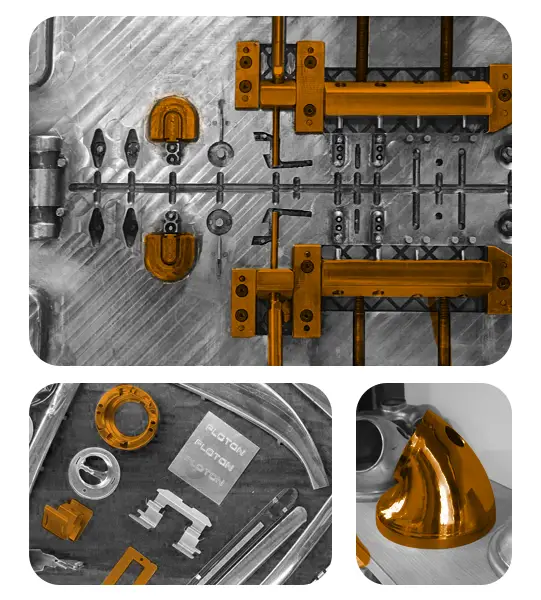Mold Manufacturing
Mold making is a manufacturing process in which a liquid material is typically poured into a mold cavity shaped as desired, and then allowed to solidify. The solidified part, known as a casting, is then removed from the mold and is ready for use. Molds play a vital role in the production of various products, and at Frafan Toos, our mission is to create professional and durable molds tailored to your specific needs. Our expertise lies in mold making and part fabrication based on your requirements!

Frequently Asked Questions
The mold design process begins with assessing the customer's requirements. Then, using advanced CAD and CAM software, a 3D model is created and, after final approval, the project proceeds to the production stage.
The time required for mold production depends on the complexity of the design and the type of mold. Typically, it takes between 2 to 8 weeks. For an accurate timeline regarding your specific project, please contact us.
Yes, we have the capability to design and manufacture a wide variety of industrial molds for industries such as automotive, electronics, medical, and packaging.
The lifespan of a mold depends on the materials used, the quality of the manufacturing process, and the volume of production. Our molds are made from high-quality materials and are designed for long-term use.
Mold Making and Mold Design (Comprehensive Version by Farafan Toos)
Since the early humans sought to build tools and utensils for better living, the idea of “shaping” different materials took root. Initially, they created basic tools by carving stones and shaping clay by hand. However, as civilization progressed, the need for mass production of uniform products emerged. This need led to the rise and development of the art and science of “mold making.” Mold making is not just a technical process but also an art that enables the precise and repeatable shaping of various materials.
Historical Roots of Mold Making
Looking at ancient civilizations, we can trace the early roots of mold making in pottery and simple metal tool production. Ancient Egyptians used clay molds for making pottery and statues. Mesopotamian civilizations employed stone molds for metal casting. In ancient China and Greece, evidence shows the use of casting molds for creating tools and jewelry.
Over time, mold making techniques evolved, and new tools and materials were developed. During the Renaissance, advances in metalworking and mechanics enabled the creation of more complex molds for precise metal parts. The Industrial Revolution marked a turning point in mold making history. With the invention of the steam engine and the rise of factories, the demand for mass production grew, and mold making established itself as a key industrial process.
What Is a Mold?
Simply put, a mold is a tool that acts as a “template” allowing raw material to be shaped into a desired form. Molds can be made from various materials including metal, plastic, wood, and even ceramic. Choosing the right material for mold construction depends on several factors, including the type of material to be shaped, the required precision, and the intended production volume.
Types of Mold Making Processes
Mold making is a vast field, encompassing different processes suited for specific applications. Key processes include:
Metal Stamping Dies:
This method is used for shaping and processing metal sheets across various industries. Metal stamping dies are usually made from high-strength steels and mainly serve in three key functions:
Cutting Dies: For precise cutting with clean edges for sheets up to 12 mm thick.
Bending Dies: For creating accurate bends with predetermined angles without wrinkling.
Drawing Dies: For producing complex hollow parts such as car body panels.
This technology is efficient for mass-producing metal parts with ±0.05 mm dimensional tolerance and production rates up to 1200 parts per hour.
Casting:
One of the oldest and most widely used mold making methods. In casting, molten material is poured into a mold and, upon cooling, takes the mold’s shape. Casting is ideal for producing complex metal parts of various sizes.
Injection Molding:
This method is used for mass production of plastic parts. Molten plastic is injected into a mold under high pressure, and after cooling, a solid plastic piece is formed. Due to its speed and precision, this method is popular for manufacturing everything from automotive parts to toys.
Compression Molding:
Used for producing composite and rubber parts, where raw material is placed into a mold and shaped under pressure combined with heat.
Extrusion Molding:
Used to produce items with a constant cross-section, like pipes, profiles, and rods. Raw material is forced through a shaped die to form the desired cross-section.
Blow Molding:
This method is used to create hollow objects like bottles and tanks. A heated plastic preform is placed into a mold and inflated using compressed air to conform to the mold shape.
Mold Design: The Fusion of Art and Engineering
Mold design is one of the most critical stages of mold making. A well-designed mold can significantly improve the quality of the final product and reduce production costs. Successful mold design requires deep knowledge of material science, fluid mechanics, heat transfer, along with creativity and innovation. Designers must account for multiple factors such as material type, part geometry, dimensional tolerances, and production conditions to create molds that are both efficient and cost-effective.
Challenges in Mold Design
Mold design presents its own unique set of challenges, including:
- Part Complexity: Modern products often feature complex geometries that make mold design difficult.
- Dimensional Precision: Produced parts must meet exact dimensions and tolerances.
- Material Properties: Different materials exhibit varying mechanical and thermal properties that must be considered during design.
- Production Cost: A mold designer must optimize designs to minimize manufacturing costs.
The Role of Mold Making in Various Industries
Mold making is critical across many industries beyond just metal and plastic part production.
- Automotive: Complex molds are used for manufacturing various car parts.
- Aerospace: Molds are crucial for creating lightweight, precise aircraft and missile components.
- Medical: Molds are used for manufacturing implants and surgical equipment.
- Packaging: Molds help produce containers and packaging for food and pharmaceuticals.
- Construction: Molds shape concrete structures used in various construction applications.
Social and Economic Impacts of Mold Making
Mold making has enabled mass production of products, improving accessibility to goods and services and boosting economic growth. Factories producing molds and industrial parts create jobs and significantly contribute to national economies. Moreover, mold making enhances quality of life by providing innovative products for daily use, encouraging technological advancements across multiple engineering fields.
Challenges Facing the Mold Making Industry
- Despite significant progress, challenges remain:
- Faster Production and Lower Costs: Companies must deliver high-quality products quickly and affordably in today’s competitive market.
- Environmental Impact: Some molding processes produce pollutants. Solutions include using eco-friendly materials and improving recycling and filtration systems.
- Increasing Complexity and Precision: Growing part complexity demands innovative design and manufacturing approaches, such as CAD, CAE, and additive manufacturing (3D printing).
Mold Making Equipment
Producing precise and high-quality molds requires advanced and specialized equipment, including:
- CNC Milling Machines: For precision machining of mold parts.
- Surface Grinders: For creating smooth and accurate surfaces.
- ZNC EDM (Electrical Discharge Machining): For forming intricate shapes in mold parts.
- Super Drill Machines: For producing small and precise holes.
- Wire EDM Machines: For cutting mold parts using a fine wire and electrical discharge.
- Lathes: For shaping and cutting rotating mold parts.
- Coordinate Measuring Machines (CMMs): For ensuring dimensional accuracy of mold components.
- Hydraulic Presses: For applying pressure during various mold production processes.
- Welding Equipment: For assembling mold components.
- Plastic Injection Machines: For testing plastic injection molds and producing sample parts.
Mold Making at Farafan Toos
At Farafan Toos, we combine the technical expertise of our specialists with advanced equipment to design and produce a wide range of industrial molds. Our focus is on delivering high-quality, precision molds that perfectly meet our clients’ needs. We produce the following types of molds:
Metal molds:
These molds are used to shape metals in various processes such as cutting, bending, forming and stretching. Each of these processes requires precise mold design according to the material and thickness of the metal sheet. Hardening of mold parts: Cold work steel 58-60 HRC, hot work steel 45-55 HRC. Coating: TRD for metal stretching molds. Service life: about 5,000,000 strokes.
Plastic or polymer molds:
These molds are used to produce plastic parts by plastic injection molding. At Farafan Toos, we design and manufacture plastic injection molds with two hot runner and cold runner systems. In hot runner molds, molten plastic is injected directly into the mold cavity, and in cold runner molds, molten material reaches the mold cavity through a separate channel system. Service life: about 5,000,000 strokes.
Die-casting molds (aluminum):
These molds are used to produce high-quality, precision aluminum parts. The die-casting process is a pressure casting method in which molten aluminum is injected into a die-casting mold. Service life: approximately 200,000 cycles.
Pricing and manufacturing time at Farafun Toos:
Due to the high quality of the molds produced at Farafun Toos, prices are very competitive. The mold manufacturing time varies between 3 and 6 months depending on the complexity of the design. All manufactured molds have a minimum warranty of 100,000 cycles.
Moldmaking as an academic discipline
Given the importance of moldmaking in the industry, this field is offered as an academic discipline in many countries. Students in this field are introduced to the principles of mold design, various moldmaking processes, materials engineering, fluid mechanics, and other related topics. Also, extensive research is conducted in universities and research centers in the field of moldmaking, with the aim of developing new technologies and improving existing processes.
The Future of Molding: Smart and Sustainable
The future of mold making is bright and full of opportunities. As new technologies advance, we will see the emergence of new methods of mold design and construction, the use of smart and environmentally friendly materials, and the development of sustainable production processes. Smart mold making, using advanced sensors and control systems, allows for precise monitoring and control of the production process, helping to improve product quality and reduce waste. Also, the use of recyclable materials and reducing energy consumption in the molding process will help to preserve the environment.
Ultimately, mold making is not only an industry, but also an art and science that allows us to shape the world around us. This field is always evolving, and we must help it progress through education, research, and innovation.
